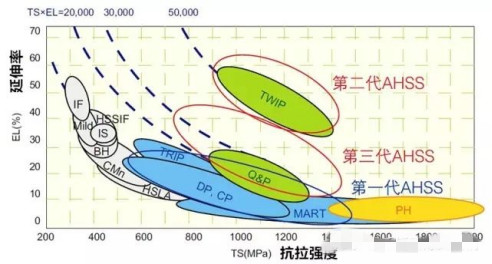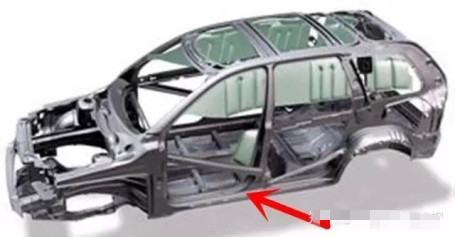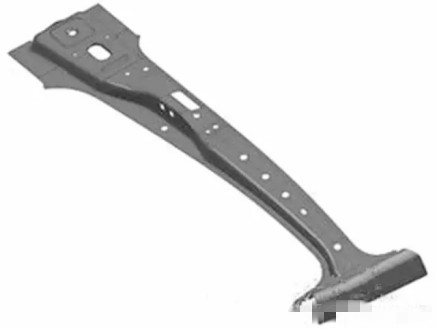Email: doquangdatktvt@gmail.com




The core of modern automobile manufacturing is safety and environmental protection, and the body requires “increasing strength and reducing weight”. Advanced high-strength steel is booming in this context, and is widely used in structural parts and safety parts of automobile bodies.

Types of high-strength steels for automobiles
1. DP Steel, Dual Phase Steels
2.CP Steel, Complex Phase Steels
3. TRIP Steel, Transformation Induced Plasticity Steels
4. MS Steel, Martensitic Steels
5.QP steel, Quenching and Partitioning Steels
6. Twinning Induced Plasticity Steels (TWIP Steel)
7. Boron steel (PH steel or B steel, Press Hardening/Boron Steels)
Duplex Steel (DP Steel)

Performance characteristics: no yield extension, no room temperature aging, low yield ratio, high work hardening index and high bake hardening value.
Typical application: DP series high-strength steel is the preferred steel for structural parts at present, and is widely used in structural parts, reinforcement parts and anti-collision parts. For example, car bottom cross members, rails, crash bars, crash bar reinforcement structures, etc.

Complex Phase Steel (CP Steel)
Features: small grains, high tensile strength. The yield strength is significantly higher than that of dual-phase steels of the same tensile strength. It has good bending performance, high hole expansion performance, high energy absorption capacity and excellent flanging forming performance.
Typical applications: Chassis suspensions, B-pillars, bumpers, seat rails, etc.

Transformation Induced Plasticity Steel (TRIP Steel)
Performance characteristics: The structure contains retained austenite and has good formability. During the forming process, the retained austenite gradually transforms into hard martensite, which is conducive to uniform deformation. TRIP steel also has the characteristics of high impact absorption energy, high strength plastic product and high n value.
Typical applications: parts with relatively complex structures, such as B-pillar stiffeners, front longitudinal beams, etc.

Martensitic Steel (MS Steel)
Performance characteristics: high yield ratio, high tensile strength, relatively low elongation, need to pay attention to the tendency of delayed cracking. It has the characteristics of high impact absorption energy, high strength plastic product and high n value.
Typical applications: cold stamping of simple parts and roll-formed parts with relatively single cross-section, such as bumpers, sill reinforcements, and crash bars in side doors.

Hardened ductile steel (QP steel)
Performance characteristics: Martensite is used as the matrix phase, and the TRIP effect of retained austenite in the deformation process can be used to achieve higher work hardening ability, so it has higher plasticity and formability than the same level of ultra-high strength steel.
Typical application: It is suitable for automobile safety parts and structural parts with complex shapes, such as A and B pillar reinforcements.
Twin Induced Plasticity Steel (TWIP Steel)
Performance characteristics: TWIP steel is a fully austenitic steel with high C, high Mn, and high Al composition. Through twinning-induced dynamic refinement, a very high work hardening capability can be achieved.
TWIP steel has ultra-high strength and ultra-high plasticity, and the strength-plastic product can reach more than 50GPa%.
Typical applications: TWIP steel has very superior formability and ultra-high strength, and is suitable for parts that require high material drawing and bulging properties, such as complex-shaped automotive safety parts and structural parts.

Boron steel (PH steel or B steel)
Performance characteristics: ultra-high strength (tensile strength above 1500MPa), effectively improving crash performance, lightweight body; complex shape of parts, good formability; high dimensional accuracy.
Typical applications: safety structural parts, such as: front and rear bumpers, A-pillars, B-pillars, middle tunnels, etc.

Evolution of automotive steel
Steel has been used in automobile manufacturing since the end of the 19th century, when German engineer Karl Benz designed the first automobile powered by an internal combustion engine in 1885.
At the beginning of the 20th century, with the emergence of steel plate/steel strip production technology and its breakthrough in complex forming processing technology, wooden components in automobile structures were gradually replaced by steel plates/steel strips.
In the century that followed, steel sheet/strip became the dominant material in the automobile manufacturing process. With the different historical periods, combined with the corresponding national strategies, consumer demand and technical capabilities, a series of automotive steel materials have evolved, as shown in Figure 1. Low carbon steel (LC) and Interstitial Free (IF) were the first to be used in automobiles.
At the time, these two types of low-strength steels could meet the needs of strength, formability, cost and design. Until the North American oil crisis around 1970, the automobile industry began to develop high-strength steel to reduce weight and save energy in response to energy problems.
Since then, it has entered a period of a virtuous cycle in which the strength level of automotive steel plates has been continuously improved. Especially under the current global trend of lightweight automobiles, workers in the steel industry are also making continuous efforts for it.

traditional high-strength steel
Traditional high-strength steels are mainly bake hardenable (BH) steels, and their mechanical properties are shown in Figure 2. The increase in strength is achieved during the paint baking process after stamping. The degree of strain hardening during the stamping process has a significant effect on the improvement of the strength during the subsequent baking process.
The strain hardening during forming is mainly based on the increase in the dislocation density caused by the deformation. The increase in strength during baking is based on the hindrance of subsequent dislocation motions caused by the diffusion of atoms during the process.
The difference in the molding method and the amount of strain caused by the molding process will have a certain impact on the bake hardening effect.
Typical first-generation advanced high-strength steel and its control technology
The first generation of advanced high-strength steels is dominated by Dual Phase (DP) and Transformation Induced Plasticity (TRIP).
DP steel, hence the name, is composed of two phases, which can be ferrite + bainite or ferrite + martensite. The schematic diagram of its structure is shown in Figure 3.
As a soft phase, ferrite ensures that it has a certain plasticity and is easy to form; bainite/martensite is used as a hard phase to make it have a reasonable strength.Schematic diagram of microstructure of DP steel
TRIP steel, the schematic diagram of its microstructure is shown in Figure 4, which consists of ferrite, martensite (bainite) and retained austenite. Due to the instantaneous large deformation of the automobile during the collision process, a certain mechanical energy is formed inside the steel plate. Combined with the internal energy stored in the original retained austenite, it undergoes a phase transformation, and part of the retained austenite is transformed into martensite, which strengthens effect.
Schematic diagram of the microstructure of TRIP steel
Typical second-generation advanced high-strength steel and its control technology
The second generation of advanced high-strength steels is dominated by Twinning Induced Plasticity (TWIP). TWIP steel is based on mechanical contractures formed due to the change of austenite phase during deformation, as shown in Figure 5. Due to the formation of contractile crystals, the energy during the collision can be absorbed.
Its basic composition is 18%Mn-3%Si-3%Al. Of course, the composition can be adjusted appropriately depending on the focus of different components on the performance of each phase and the bottleneck problem in the production process.
contractures formed during deformation
Development of the third generation of advanced high-strength steel
The third-generation advanced high-strength steel is based on the gap between the first-generation and second-generation high-strength steels, and develops varieties with high strength and high plasticity with excellent comprehensive properties, such as Q&P (Quenching and Partition) steel, a research hotspot at home and abroad.
The room temperature structure of Q&P steel is ferrite, martensite and austenite. The design principle is that after quenching to a certain temperature to form a considerable amount of martensite, there is a secondary heating process, as shown in Figure 6, in This process achieves the diffusion of carbon atoms in the martensite into the retained austenite, thereby improving its stability.
The high-strength steel produced by this process has a strength-plastic product that far exceeds the first and second generation advanced high-strength steels.

Q&P Steel Process Control Process
Development Trend and Research Hotspot of Automobile Steel
Through the application of high-strength steel, various parts of the body can be thinned without losing strength. It has been agreed in Europe and the United States that through the application of 600MPa/40% to 1600MPa/20% high-strength steel in the body structure, the body weight can be reduced by at least 5-8%, which brings opportunities for the development of various series of high-strength steels within this performance range.
For the next development direction and research topics of automotive steel, the international NSF (National Steel Fabrication), the US DOE (Department of Energy) Department of Energy, the American AISI (American Iron and Steel Institute) and A/SP (Auto/ Steel Partnership), which proposes the following research areas at universities and research institutes:
Microstructure and mechanical properties of advanced high-strength steels;
Carbon Diffusion Process in Advanced High Strength Steel;
Particle size and interface effects of advanced high-strength steels;
Nano-acicular ferritic dual-phase steels in advanced high-strength steels;
High-strength and high-plastic bainitic steel;
Formability and springback behavior of advanced high-strength steels;
Corresponding models for advanced high strength steels.
Demand will promote the progress of related technologies, and technological progress will also stimulate the increase of demand. The general trend of light weight will promote the continuous progress of technology in the steel industry, thereby creating conditions for the application of more advanced steel plates.
The development direction of automobile steel in the next step, or the more ideal automobile steel plate material in this era, should have the following conditions: low carbon (high weldability), low cost (addition of low alloy content), high formability, Easy assembly and maintenance.
Nowadays, various series of high-strength steels for vehicles generally have certain limitations, such as large differences in composition and inconsistent surface quality, which bring certain difficulties to the final coating. In the future, the evaluation of various materials should be considered from the perspective of the whole process, so as to design and produce good and practical products.
By: Cosa steel